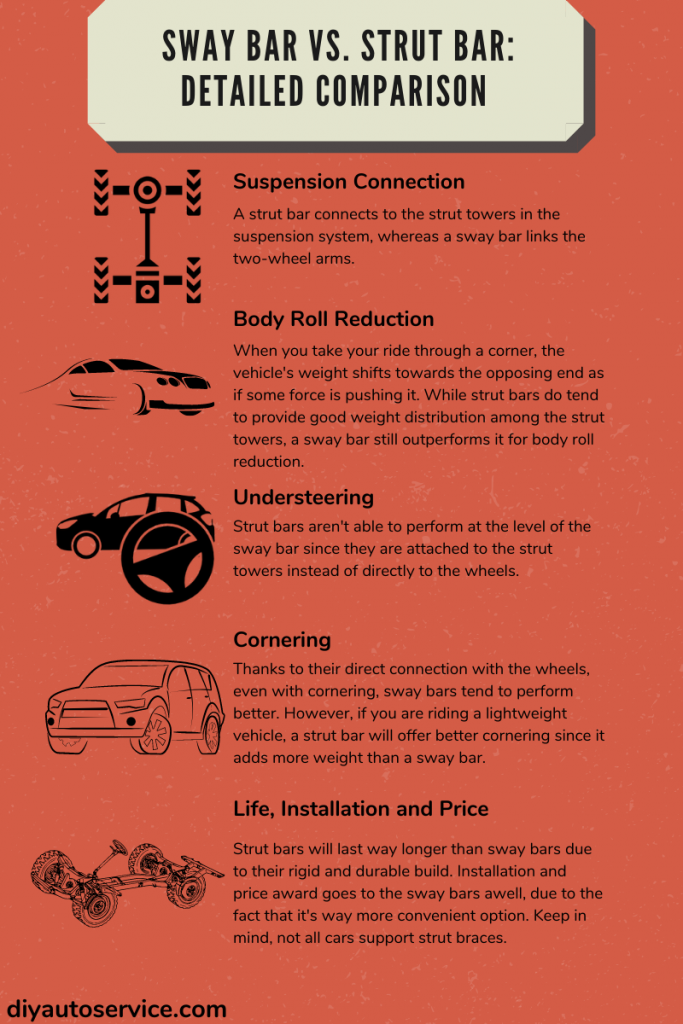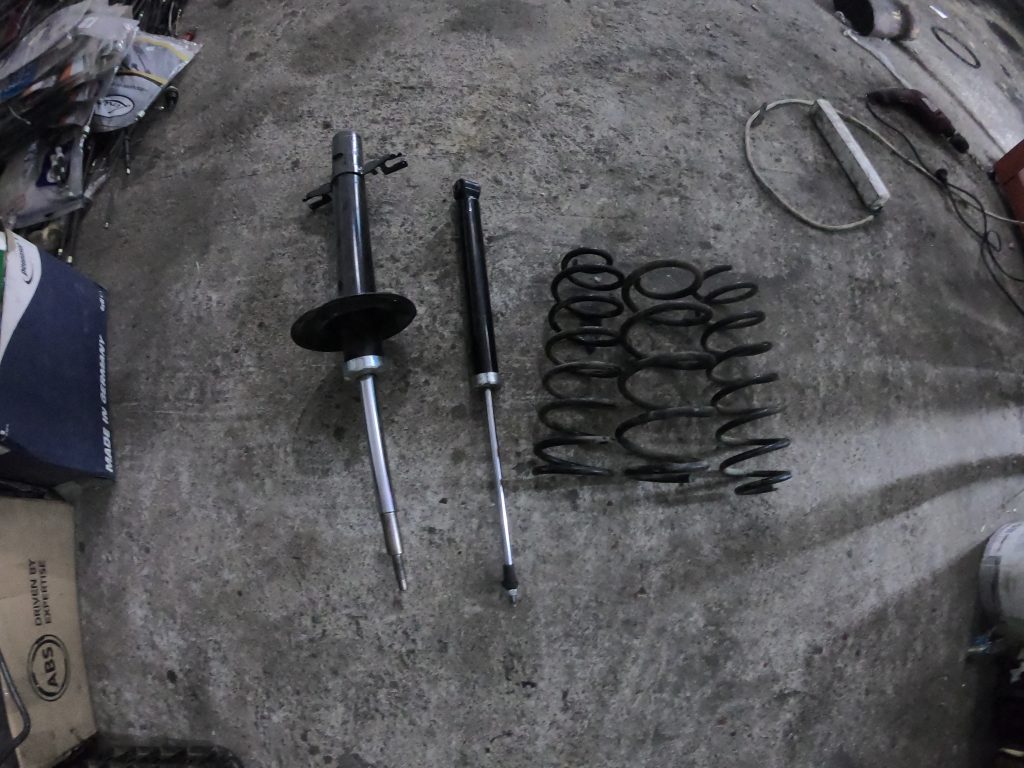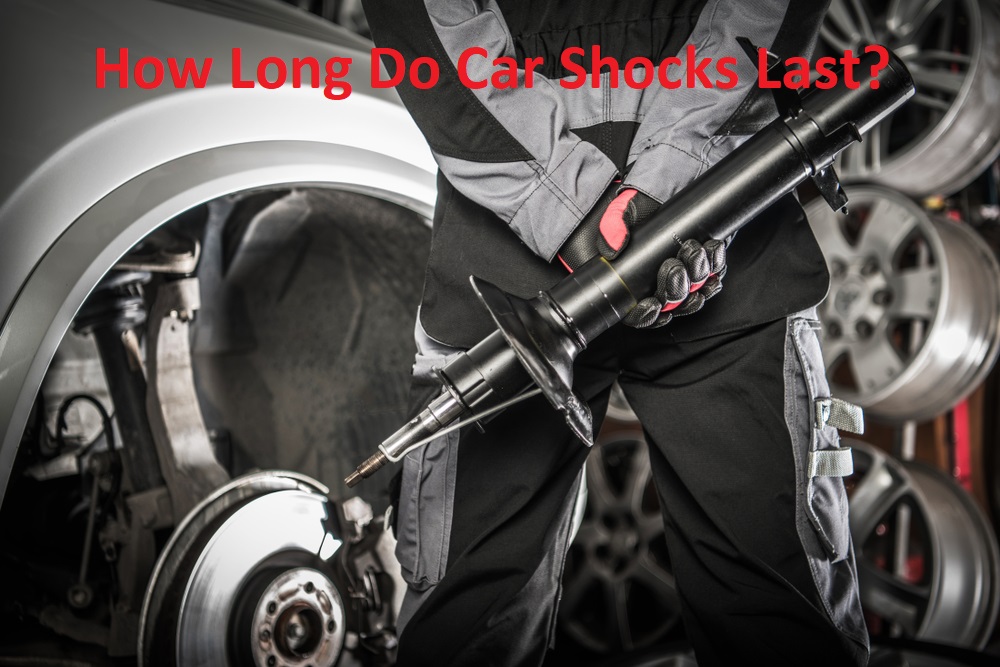Strut bars and sway bars are known to enhance the overall cornering and handling of the vehicle. You get a more rigid and better cornering with strut bar and less body roll and understeering with sway bar.
They are both quite effective at what they do, so it only makes sense to install both in your car, right? Well, I hate to break it to you, but you cannot install both.
So, which one should you go for when it comes to sway bar vs. strut bar? If I were to give a brief answer, a sway bar. But let’s see why!
Strut bars are installed to connect the strut towers, whereas sway bars help connect the wheels. On top of it, a sway bar performs way better for body roll reduction. Moreover, it also has better understeering performance and a significantly easier installation process than a strut bar.
Now you must be thinking sway bar is the easy choice here. But don’t rush into it. While it is the better option of the two, you should read my detailed analysis to make an informed decision for your ride.
Sway Bar vs. Strut Bar- General Comparison
Let’s begin the detailed comparison right after this table which offers a quick overview of the differences between sway bars vs. strut bars:
| Feature | Sway Bar | Strut Bar |
| Connection | Links Two Wheel Arms | Strut Towers |
| Body Roll Reduction | Great | Good |
| Understeering | Excellent | Average |
| Installation | Extremely easy | Requires time and skill |
| High-Speed Cornering | Good | Great |
| Low-Speed Cornering | Good | Good |
| Life | Short | Long |
| Price | Budget-friendly | Relatively Expensive |
What Is A Sway Bar?
A sway bar acts as a part of your ride’s suspension system, which also includes the shocks, springs, wheels, steering system, joints, bushings, and linkages.
Sway bars are designed to enhance your ride’s handling when it goes over sharp turns at high speeds. They help minimize the chassis flex or body lean and handle turns more stably.
As a result, it is a great suspension part for RVs and coaches since they tend to require more stability over hard corners.
At its core, a sway bar is in other words called torsion spring – it simply counteracts the twisting movement in a vehicle when taking turns. A sway bar successfully fights the tilting feel at turns and levels out everything for a smooth turn, even at high speeds.
What Does A Sway Bar Do?
As I mentioned earlier, a sway bar helps prevent chassis flex while a vehicle goes over a hard corner. This is especially an issue if you are riding a large vehicle such as a coach, RV, or truck. These heavyweight vehicles tend to distribute the force to the opposite side of the turn.
As a result of this, the opposite side of the vehicle tends to light higher than the side facing the turn. You will also feel that the tires on the opposite end are lifted a bit higher. A sway bar comes in handy to keep the tires at the same level, thereby keeping the whole vehicle leveled.
As the car faces a twisting movement while taking a turn, the sway bar simply works to counter it to keep the vehicle wheels leveled. As a result, sway bars help minimize body roll when going overturns at high speeds. This is incredible for your and the vehicle’s safety.
More importantly, sway bars also provide a better road grip and help prevent lopsided wheel alignment. Now let me tell you what a strut bar is and what it does before I compare both.
If you are wondering which aftermarket sway bar brand or sway bar end links will be the perfect fit for your vehicle, I highly suggest you to read the guides that I have linked.
What Is a Strut Bar?
A strut bar, also known as a strut tower or brace, works as a connecting rod between your strut towers and suspension. As a result, it helps reinforce the whole chassis by keeping the two stress points intact.
They are mainly used to overcome the limitations of a MacPherson Strut assembly which bears a heavy load where it connects to the car body. The MacPherson Strut assembly design puts extreme pressure on the strut power, especially while hitting speed bumps and hard corners.
The pressure put on the strut bars under these circumstances is enough to dealing the car’s suspension, bringing down the overall performance. As a result, struts were introduced to make sure the suspension alignment maintained its original form even when hitting bumps at high speeds or at instances of hard cornering.
Initially, strut bars were introduced to enhance the performance of the MacPherson strut suspension system. However, over time, people began using strut bars with other types of suspension systems and enjoyed the same benefits.
What Does a Strut Bar Do?
People often confuse handling and performance when it comes to vehicles. While performance has to do with acceleration and speed, handling has more to do with how a car responds and feels. Usually, cars with good handling are easier to control at higher speeds.
A strut bar is also mainly used to enhance the handling of the ride when it’s being put to its performance limits. They are not designed to increase your lap times or cornering speed. However, strut bars do make the ride more predictable and in control when cornering at higher speeds.
Strut bars achieve better handling and control by redistributing the excess pressure to the alternate strut tower. As a result, the chassis flex is significantly reduced at hard corners, making your car more stable even if you are at high speeds. People also say that cars with strut bars feel more rigid, which is true.
Sway Bar vs. Strut Bar: Detailed Comparison

Most people get confused between sway bar vs. strut bar because of the similar functionality they offer. Which is fine because they both mainly serve the same purpose. But here are some major differences that will help you decide between a strut bar vs. a sway bar:
Suspension System Connection
While you must have noticed that the purpose served by both sway bar vs. strut bar is almost the same, the major difference lies in how the two bars are connected to the suspension system.
A strut bar connects to the strut towers in the suspension system, whereas a sway bar links the two-wheel arms.
The strut bar connection helps reduce chassis flex as well as add stiffness to the vehicle. On the other hand, the sway bar link helps keep the two wheels balanced.
It is also important to note that strut towers are not in direct contact with the vehicle’s chassis. As a result, they handle the pressure and weight while hard cornering by balancing them between the strut bars.
Body Roll Reduction
When you take your ride through a corner, the vehicle’s weight shifts towards the opposing end as if some force is pushing it. This is what we call body roll, and both strut bar and sway bar are designed to minimize it.
But the difference lies in how these two bars help reduce body roll.
A strut bar achieves this by transmitting the force between the strut towers. However, due to the high position of the strut towers than the wheels, they aren’t able to take in enough weight.
On the other hand, a sway bar restricts the tilting movement over a turn by linking both wheel arms. As a result, the sway bar is able to transfer force between the two-wheel arms, maintaining a balance that keeps the car on the road.
While strut bars do tend to provide good weight distribution among the strut towers, a sway bar still outperforms it for body roll reduction.
Understeering
Understeering occurs when the vehicle is at high speeds and is unable to stay on the road due to a lack of steering. This is a common issue with stiff suspension systems with stiff shocks and springs. However, springs and shocks are necessary for road grip.
As a result, you can install a sway bar that significantly reduces understeering. The only reason why sway bars are able to achieve this is because of their direct connection to the wheels.
On the other hand, strut bars do offer the same functionality. However, they aren’t able to perform at the level of the sway bar since they are attached to the strut towers instead of directly to the wheels.
Cornering
Cornering is another area that both sway bar vs. strut bar tends to affect. Thanks to their direct connection with the wheels, even with cornering, sway bars tend to perform better. However, this is only true for heavyweight vehicles and at low speeds.
A sway bar can offer better weight distribution and cornering if combined with the right camber. While strut bars tend to add weight to the vehicle, which helps with stability and balance, not all cars need them.
However, if you are riding a lightweight vehicle, a strut bar will offer better cornering since it adds more weight than a sway bar. As a result, the ride will be more stable and balanced even at higher speeds.
Life
Sway bars don’t tend to come in contact with other suspension parts. As a result, they are not built to withstand heavy wear and tear. Therefore, it is likely that they will get worn out sooner.
On the other hand, Strut bars do come in contact with other suspension parts. As a result, they are made to be extremely strong and durable, allowing them to last for longer, usually 6-10 years.
Installation and Price
The last thing you must consider is the installation and price of sway bar vs. strut bar.
The sway bar wins here because it is cheaper and easier to install than a strut bar. More importantly, it is a convenient option because all cars do not necessarily support strut bars.
FAQ:
Can You Drive Without a Sway Bar or Strut Bar?
Yes, you can drive a vehicle without a sway bar or a strut bar. The ride quality will feel different, but the absence of either does not make the ride undrivable.
Do Strut Bars Affect Ride Quality?
Yes, strut bars do affect the ride quality. They tend to make the ride stiffer and more stable. Whether this is better ride quality or not depends on what you expect from the ride and personal preferences.
Can You Make a Strut Bar Yourself and Work Properly as the Stock One?
Yes, you can, but it is not recommended. Unless you are a professional who knows the anatomy and functionality of a strut bar, you should only resort to company-manufactured products for your ride. This is important for ride safety as well as your own.
Otherwise, if you would like to experiment, always be careful and make sure to follow exact instructions on how to make a strut brace.
To Conclude
I hope everything I have mentioned above makes sense. Both sway bar vs. strut bar serve almost the same purpose, but one does it better than the other.
If you are still confused about which one is better, let me make it easy for you. A sway bar not only offers better performance but is also easier to install and cheaper on the pocket.
But if you really want a rigid ride and extremely comfortable cornering, a strut bar is also a great option. The final decision is yours!





